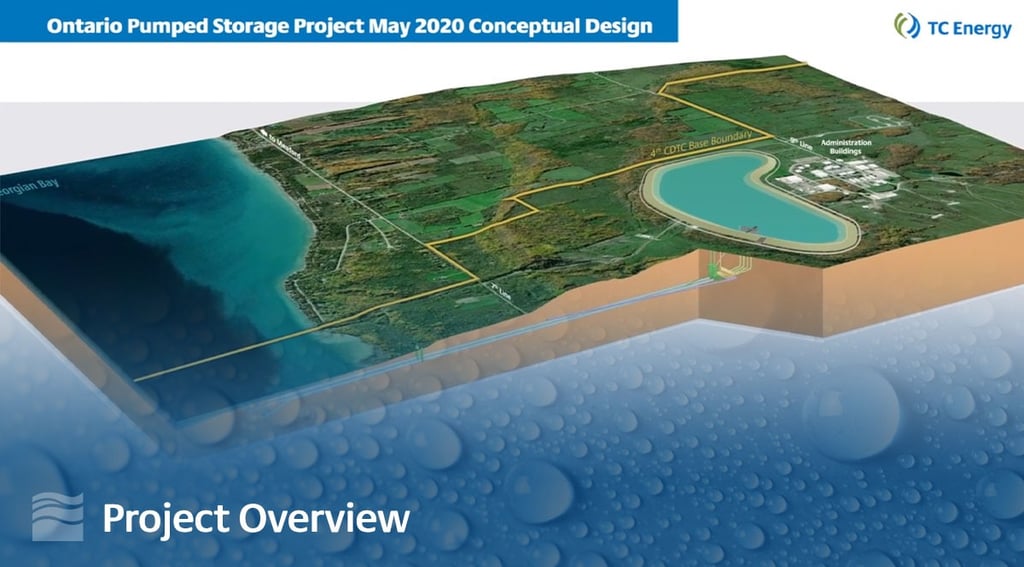Beneath the Surface: Is “Green” Energy About to Tarnish Georgian Bay?
TC Energy’s proposed pumped storage project in Meaford is being sold as “green energy,” but it may hide a toxic truth. The site sits on Department of National Defence land with decades of live-fire training, raising serious concerns about contaminated soil and sediment being released into Georgian Bay. We’ve compiled the facts and the risks — click below to read the full story and learn what’s at stake for our waters.
Erik Schomann
8/9/20253 min read


Imagine the pristine waters of Georgian Bay — deep, cold, and ancient — being repurposed not for swimming, sailing, or spawning fish, but for something far more industrial: a giant battery.
That’s the vision TC Energy (TCE) is promoting in Meaford, Ontario. Their proposed 1,000-megawatt pumped hydroelectric storage facility, planned for development on Department of National Defence land, is being hailed as a green energy solution. But many residents, environmental groups, and scientists are questioning whether the proposal is “green” in name only.
What Is Pumped Storage, Anyway?
In theory, it’s simple. The system pumps water uphill into a reservoir when electricity demand is low, then releases it downhill through turbines when demand is high. This stores and later returns energy to the grid — acting like a rechargeable battery.
TCE claims this would be Ontario’s largest energy storage project, improving reliability, enabling renewable growth, and saving consumers money. Construction would begin in 2028, with operations projected to start in 2032. (Meaford.ca, OntarioPumpedStorage.com)
Sounds Good... So Why the Backlash?
Because not everything green is clean — and critics say the environmental costs far outweigh the benefits.
Save Georgian Bay, a grassroots organization that formed shortly after the project’s announcement in 2019, has long sounded the alarm. They argue that the project risks catastrophic impacts to:
· Water quality: Pumping and draining 23 million litres per hour (over half-billion litres/day) could stir up decades of contaminated sediment, especially at a site where military training exercises have left heavy metals, explosives residue, and other hazardous materials embedded in the soil and lakebed.
· Soil and sediment toxicity: The DND’s 4th Canadian Division Training Centre has hosted live fire exercises, explosives testing, and ordinance disposal for over 80 years. The site is known to have potentially toxic legacy contamination — but no full, independent remediation study has been released to the public.
Aquatic life: Massive intake tunnels could cause fish mortality and disrupt spawning grounds.
Species at risk: Including at least 12 identified species protected under provincial and federal law.
The Niagara Escarpment: A UNESCO Biosphere Reserve that could face visual, ecological, and hydrological degradation.
Ratepayer wallets: With a projected $7–10 billion price tag, ratepayers may be on the hook for a megaproject that fails to deliver competitive value. (SaveGeorgianBay.ca, GeorgianBay.ca)
The Independent Electricity System Operator (IESO) has also noted the project is not the most cost-effective solution — yet it continues to receive high-level political support and even public funds. Ontario’s government pledged up to $285 million to help TCE advance project design and assessment work. (SaveGeorgianBay.ca, GeorgianBay.ca)
Alternatives Exist — So Why Aren’t We Using Them?
Ontario is already investing in grid-scale lithium-ion battery storage, which offers 87–90% round-trip efficiency, compared to pumped hydro’s ~67%. Batteries are faster to deploy, leave a smaller physical footprint, and can be located near urban centres — without threatening world-class watersheds.
Groups like the Georgian Bay Association (GBA) argue that the TCE project is “a solution in search of a problem,” out of step with both modern technology and environmental responsibility.
Where Does Tiny Township Stand?
Tiny Township has not yet formally declared a position — but they are watching. The Severn Sound Environmental Association has been tasked with preparing a report evaluating the potential impacts on the broader Georgian Bay ecosystem, including our own shores. That report is due imminently.
Why Should We in Tiny Care?
Because Georgian Bay doesn’t stop at Meaford.
Turbidity, toxicity, and ecological disruption don’t obey municipal boundaries. Tiny’s residents — many of whom have spent years defending their land and water against destructive development — should be concerned about this project’s precedent.
Moreover, local democracy matters. Meaford council approved the project conditionally in 2023, but widespread public consultation has been inconsistent, and many feel unheard. That echoes our own experiences in Tiny Township.
What Can You Do?
If you’re concerned about the environmental and financial implications of this megaproject, here’s how you can act:
Watch for the Severn Sound Environmental Association report — and ask your local councillors how they plan to respond. Contact the Ontario Ministry of the Environment, Conservation and Parks and ask them to rigorously assess the ecological risks:
Share this information with others who love and rely on Georgian Bay.
Conclusion: A Fork in the Stream
The TC Energy pumped storage project may promise stability on the grid, but it could come at the cost of instability in the lake. As this project inches forward, we urge residents of Tiny and across the Georgian Bay watershed to pay attention, ask questions, and demand transparency.
Because once the water is fouled, no amount of power can pump it clean again.


